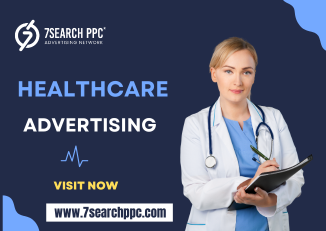How to Create Effective Healthcare Advertising Campaigns That Build Trust
Healthcare advertising plays a vital role in connecting patients with the services they need, educating the public about health options, and establishing trust with providers. As the healthcare landscape becomes increasingly competitive and digital-first, it’s essential to craft campaigns that resonate emotionally, ethically, and effectively.
In this guide, we’ll walk through the most important steps to create powerful healthcare advertising campaigns that drive results — whether you’re a hospital, clinic, pharmaceutical brand, or healthcare creative agency.

Why Healthcare Advertising Matters
In today’s digital world, healthcare consumers actively search online for treatments, doctors, wellness information, and health insurance. If your healthcare brand doesn’t show up in their search or fails to leave an impact, you risk losing them to more strategic competitors.
Effective healthcare advertising builds brand credibility, boosts patient acquisition, and improves community outreach. From traditional media to modern health and fitness ads, your brand needs a multi-platform strategy to reach and retain your target audience.
Understand Your Audience
Every great campaign begins with a deep understanding of who you’re trying to reach.
Demographics: Age, gender, income, location.
Psychographics: Health goals, lifestyle, attitudes toward healthcare.
Behavior: Do they search online for health solutions? Are they influenced by testimonials or reviews?
Knowing this helps you craft messages that matter. For example, fitness-focused ads for a young, active audience should differ significantly from senior-care promotions aimed at retirees.
Define Clear Campaign Objectives
Your healthcare advertising campaign should have specific goals. Examples include:
Increasing patient appointments for a particular service (e.g., dermatology or pediatrics).
Boosting awareness for a new health facility or practice.
Driving traffic to your health blog or YouTube health series.
Promoting preventive care like vaccinations or check-ups.
The more measurable your goal (e.g., “increase flu shot appointments by 25% in Q4”), the better you can track success.
Leverage a Healthcare Creative Agency
Many healthcare providers turn to a healthcare creative agency to bridge the gap between medical expertise and creative marketing. These agencies specialize in:
Developing patient-centric branding.
Creating emotionally impactful ads.
Navigating healthcare regulations (HIPAA, FDA guidelines, etc.).
Designing multi-platform ad strategies (digital, print, social, video).
Partnering with experts allows you to remain compliant while crafting messages that spark interest and trust.
Choose the Right Channels
Your audience won’t all be on one platform. The best healthcare ad campaigns use a blend of online and offline channels, such as:
Search Engine Ads (Google Ads for health-related keywords).
Ad Network Boost your business with 7Search PPC—targeted ads, cost-effective campaigns, and reliable traffic to drive your success. Try it today!
Boost Your Brand Now!
Social Media (Facebook, Instagram, TikTok for health and wellness tips).
Video Marketing (YouTube explainer videos, patient testimonials).
Out-of-Home (Billboards, transit ads near clinics or hospitals).
Email Campaigns (Wellness newsletters, appointment reminders).
If you’re promoting health and fitness ads, platforms like Instagram and YouTube are ideal due to their visual and interactive nature. However, for more serious or elder-targeted campaigns, Facebook and direct mail may be more effective.

Craft a Compelling Message
Your messaging must strike a balance between empathy, clarity, and authority. Effective healthcare messaging often includes:
A Clear Value Proposition: What do patients gain? Faster recovery? Access to top doctors?
Trust-Building Elements: Testimonials, accreditations, or doctor profiles.
Action-Oriented Language: Use call-to-actions like “Book Now,” “Get Your Free Screening,” or “Talk to a Health Specialist.”
Emotional appeal is powerful in healthcare advertising, especially when addressing fear, hope, or relief. But don’t overdo it — authenticity and compassion should remain central.
Visuals That Build Confidence
In healthcare, visuals do more than attract attention — they create comfort and trust. Whether you’re designing health and fitness ads or complex service promotions, your visuals should:
Feature real people (diverse, relatable patients or professionals).
Use calming, professional color schemes (blues, whites, and greens).
Avoid clutter — clean, readable layouts signal professionalism.
Healthcare ad agencies often work with photographers and designers who understand how to portray healthcare settings in a reassuring, human way.
Prioritize Compliance and Ethics
Healthcare marketing is one of the most regulated fields. Always adhere to:
HIPAA Regulations: Never reveal private patient information without consent.
FDA Guidelines: Especially for pharma products — avoid misleading claims.
AMA Marketing Ethics: Transparency, fairness, and truthfulness are non-negotiable.
A health care marketing agency will guide you through compliance and offer legal vetting for content. It’s crucial to get this right to avoid fines and damage to your reputation.
Track, Optimize, Repeat
Use analytics to monitor your campaign performance. Key metrics include:
Click-through Rates (CTR)
Conversion Rates (Appointments, Calls)
Engagement Rates (Social shares, video views)
Return on Investment (ROI)
Split test ads, try different platforms, or alter visuals to improve results. Modern healthcare ad agencies use A/B testing and heat maps to refine campaigns over time.
Examples of Effective Healthcare Advertising
Mayo Clinic’s YouTube Channel – Combines expert interviews, patient testimonials, and condition explainers.
Cleveland Clinic’s “Empathy” Campaign – A video ad series that went viral by focusing on human emotion in hospitals.
Kaiser Permanente’s “Thrive” Campaign – Health and wellness branding with uplifting visuals and positive lifestyle messaging.
One Medical’s Digital Ads – Targeted Google Ads emphasizing fast, personalized primary care access.
Each of these campaigns exemplifies the balance between emotion, expertise, and accessibility — key ingredients of healthcare ad success.
Conclusion
Creating effective healthcare advertising campaigns is both an art and a science. It requires knowing your audience, crafting emotionally resonant messages, maintaining regulatory compliance, and leveraging the right media platforms. Whether you’re handling campaigns internally or partnering with a healthcare creative agency or healthcare ad agency, strategic planning and ongoing optimization are the keys to long-term success.
As patient behaviors continue to evolve, your healthcare brand must evolve too. From health and fitness ads to wellness newsletters, your message can save lives — but only if it reaches the right people in the right way.
FAQs
What is the best platform for healthcare advertising?
Ans: It depends on your audience. Google Ads is effective for high-intent searches, while Facebook and Instagram work well for community engagement and health and fitness ads. YouTube is ideal for educational video content.
Can I run healthcare ads without violating HIPAA?
Ans: Yes. Always get explicit patient consent for testimonials or images and avoid using any Protected Health Information (PHI) without proper clearance. A health care marketing agency can help ensure compliance.
What’s the difference between a healthcare creative agency and a healthcare ad agency?
Ans: A healthcare creative agency focuses on branding, storytelling, and design, while a healthcare ad agency is more focused on media buying, campaign execution, and performance optimization.
How much should I budget for a healthcare advertising campaign?
Ans: Budgets vary depending on goals, platform, and region. Small local campaigns might run on $2,000–$5,000/month, while national campaigns could exceed $50,000/month. Partnering with a healthcare ad agency can help optimize spending.
How do I know if my healthcare ads are working?
Ans: Track key performance indicators (KPIs) such as clicks, form fills, appointment bookings, and overall ROI. Use analytics tools and A/B testing for ongoing improvements.
